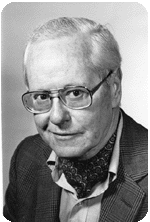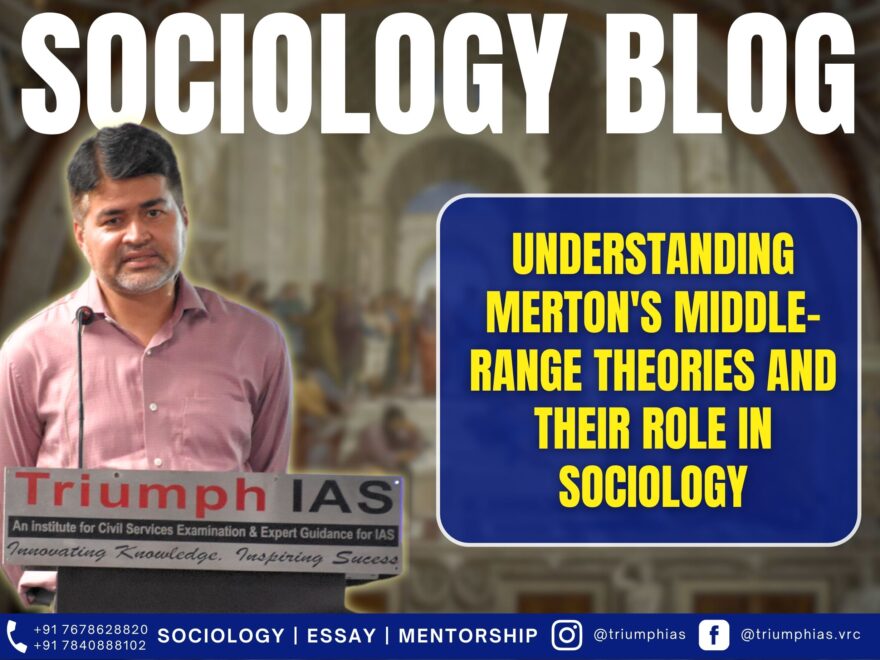
The purely abstract theorist runs the risk that, as with modern decor, the furniture of the mind will be sparse, bare, and uncomfortable.
Theories of the Middle Range
Relevant for Sociology Paper-1 (Unit-4)
- Merton’s middle-range theories emerged as a rejection of Parsonian sociology’s grand theories. According to Merton, sociology should not be driven by intellectual aggression or speculative notions. Instead, it should focus on arranging empirical facts in a coherent manner. Sociological theories should be grounded in factual evidence and aim to explain these facts systematically. Rather than being preoccupied with grand speculations about social systems involving exchange, negotiation, convergence, control, and integration, sociology should address real problems and empirical issues.
- During the 1960s in America, there was a significant display of political corruption, ethnic conflict, and deviant behavior. Merton took an interest in studying these phenomena and explained them using simplified theoretical frameworks, which he termed middle-range theories. In contrast to grand theories, Merton argued that these middle-range theories are more aligned with empirical realities. Grand theories tend to be highly abstract and lack relevance in understanding the essence of social reality. Therefore, sociology should reject grand theoretical constructs and instead embrace middle-range theories.
- Merton also highlighted the incompatibility of natural science theories with sociology. He emphasized that natural science theories are the result of cumulative research conducted by a large body of scholars over time and space. In the natural sciences, it is possible to modify, amend, or revise theories based on contemporary problems and issues. However, in sociology, phenomena such as the form of capitalism, patterns of democracy, and the role of the family are subject to constant change in different contexts. Therefore, sociology should primarily focus on the diversity and variability present in social structures and functions, rather than striving for scientific status by adopting natural science theories. Merton drew inspiration from Weber’s sociology and highlighted the need for sociology to study the essence of reality instead of attempting to grasp the totality of it.
- Middle-range theories in sociology prioritize the importance of empirical research facts over theories. These theories are concise, easily understandable, and universally accepted conceptual frameworks that emerge from specific empirical situations. They have the capacity to explain various situations without ambiguity or controversy. Examples of middle-range theories include the reference group theory and the concept of in-group or out-group, which provide guidance for sociological research in different contexts.
Paradigm for functional analysis:
Merton outlined the stages of the functional approach through a structured framework called the functional paradigm. He started by examining the shortcomings of early functionalists, specifically Malinowski and Radcliffe-Brown. Merton identified three problematic assumptions within functional theorizing:
- The assumption of the functional unity of social sciences.
- The assumption of the functional universality of social elements.
- The assumption of the indispensability of functional elements within social systems.
- The postulate of functional unity: Merton argues that functionalists have often mistakenly treated the hypothesis of social systems exhibiting social integration as a necessary condition or requirement for social integration. While it is undeniable that human society possesses some level of integration, assuming that a high degree of functional unity must exist in a social system undermines the possibility of empirically verifying it. This presumption of high functional unity has resulted in a conservative bias and an ideological slant within the functional approach, evident in the works of functionalists from Durkheim to Talcott Parsons. Therefore, the extent of functional unity in a social system should be subject to empirical investigation.
- The postulate of functional universality: One consequence of emphasizing high functional unity was the belief among early functionalists that if a social element exists within an ongoing system, it must have positive consequences for the system’s integration. In its extreme form, this line of reasoning led Malinowski to assert that every custom, material object, idea, and belief fulfills some vital function. However, Merton argues that an examination of actual existing systems reveals a wide range of empirical possibilities.
- Firstly, items can have both positive and negative functional effects on a system or its components. Some consequences, whether functional or dysfunctional, are intended and recognized by the system (manifest), while others are unintended or unrecognized (latent). Functional analysis should therefore consider the net balance of consequences for the specific social system under study.
- The postulate of functional indispensability: A natural consequence of assuming that “all parts are functional” is the belief that the existence of all parts is essential for the survival of the social system. Consequently, all parts are considered functionally indispensable. Merton strongly argues that such conclusions, taken for granted by various functionalists, are unwarranted based on empirical evidence. A closer examination of the empirical world reveals that alternative structures can exist to fulfill the same basic requirements in diverse social systems. This leads Merton to propose the significance of identifying various types of functional alternatives or equivalents within social systems in functional analysis. Moreover, when searching for functional alternatives, attention should be given to determining the range of items that can serve as functional equivalents within the existing structural constraints of the social systems.
After conducting a thorough examination of the drawbacks of functional analysis, Merton puts forth a set of guidelines for his functional paradigm. He emphasizes the importance of starting the functional analysis with a straightforward description of the behaviors and actions of individuals and groups being studied. By observing and documenting the patterns of interaction and activity among the units under investigation, it becomes possible to identify the specific social elements that should undergo functional analysis. These descriptions can also offer valuable insights into the functions fulfilled by these structured activities.
In order for these functions to become more evident, however additional steps are necessary :
- The initial step in this process is for researchers to identify the main alternatives that are excluded due to the dominance of a specific pattern. Describing these excluded alternatives provides insights into the structural context from which the observed pattern arises and persists. This, in turn, offers further indications about the functions or outcomes that the item may have for other items and potentially for the entire system.
- Moving beyond mere description, the second analytical step involves evaluating the meaning and emotional significance of the activity for group members. Exploring these meanings can offer some understanding of the motives behind individuals’ actions and provide initial insights into the manifest and latent functions of the activity.
- These descriptions necessitate a third analytical step: identifying the range of motives that drive conformity or deviation among participants. By comprehending the configuration of motives that shape actors’ behaviours, it becomes possible to assess the psychological needs fulfilled or unfulfilled by a particular pattern. This offers additional clues regarding the various functions of the pattern under investigation.
- Lastly, the final analytical step involves describing how the investigated patterns reveal regularities that may go unnoticed by participants but have consequences for both individuals and the system as a whole. This highlights the significance of these patterns and their impact on the actors involved and the overall system.
Analysis :
- Recognition of essential elements for actual functions: Initially, the researchers should include only those elements in their study that serve a functional and necessary purpose for the tasks at hand. Unnecessary elements should be excluded. The degree of necessity for these elements can be determined through the examination of the study material or patterns. For instance, when studying the development of rural structures, the level of awareness campaigns should be considered alongside the infrastructure.
- Importance of objective consequences: According to Merton, both functional and dysfunctional elements are present within a single activity, and the observer should objectively assess the balance between the two. The net balance is calculated as the sum of the functions and dysfunctions. For example, television serves as a significant source of information, knowledge, and entertainment in a positive sense. However, it can also contribute to consumerism, vulgarity, and violent activities in a negative sense. Therefore, the observer must carefully consider the net balance of these consequences.
Concepts of units under functions:
- Functions: These are consequences that are observed and contribute to the proper functioning and adjustment of the system or its associated elements.
- Dysfunction: These are observed consequences that hinder or reduce the system’s ability to adapt and adjust, making them detrimental to the system.
- Manifest Function: These are observed consequences that ensure proper coordination within the system. They are intended by the system and are commonly known and recognized by everyone.
- Latent Function: These functions are unintended and often go unnoticed or unacknowledged by the system. They are secondary consequences that arise from the manifest functions.
To master these intricacies and fare well in the Sociology Optional Syllabus, aspiring sociologists might benefit from guidance by the Best Sociology Optional Teacher and participation in the Best Sociology Optional Coaching. These avenues provide comprehensive assistance, ensuring a solid understanding of sociology’s diverse methodologies and techniques
Merton, middle-range theories, sociology, functional paradigm, empirical evidence, social systems, manifest function, latent function, dysfunction, social reality, functional analysis
Follow us :
🔎 https://www.instagram.com/triumphias
🔎https://www.youtube.com/c/TriumphIAS
https://t.me/VikashRanjanSociology
Find More Blogs
|
Scope of the subject and comparison with other social sciences |
|||
|
|
|
|
Modernity and social changes in Europe |



One comment